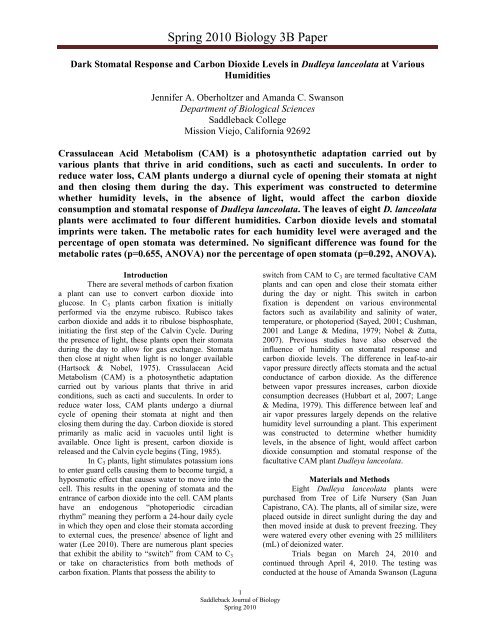Saddleback Journal of Biology - Saddleback College
Saddleback Journal of Biology - Saddleback College
Saddleback Journal of Biology - Saddleback College
You also want an ePaper? Increase the reach of your titles
YUMPU automatically turns print PDFs into web optimized ePapers that Google loves.
Spring 2010 <strong>Biology</strong> 3B Paper<br />
Dark Stomatal Response and Carbon Dioxide Levels in Dudleya lanceolata at Various<br />
Humidities<br />
Jennifer A. Oberholtzer and Amanda C. Swanson<br />
Department <strong>of</strong> Biological Sciences<br />
<strong>Saddleback</strong> <strong>College</strong><br />
Mission Viejo, California 92692<br />
Crassulacean Acid Metabolism (CAM) is a photosynthetic adaptation carried out by<br />
various plants that thrive in arid conditions, such as cacti and succulents. In order to<br />
reduce water loss, CAM plants undergo a diurnal cycle <strong>of</strong> opening their stomata at night<br />
and then closing them during the day. This experiment was constructed to determine<br />
whether humidity levels, in the absence <strong>of</strong> light, would affect the carbon dioxide<br />
consumption and stomatal response <strong>of</strong> Dudleya lanceolata. The leaves <strong>of</strong> eight D. lanceolata<br />
plants were acclimated to four different humidities. Carbon dioxide levels and stomatal<br />
imprints were taken. The metabolic rates for each humidity level were averaged and the<br />
percentage <strong>of</strong> open stomata was determined. No significant difference was found for the<br />
metabolic rates (p=0.655, ANOVA) nor the percentage <strong>of</strong> open stomata (p=0.292, ANOVA).<br />
Introduction<br />
There are several methods <strong>of</strong> carbon fixation<br />
a plant can use to convert carbon dioxide into<br />
glucose. In C 3 plants carbon fixation is initially<br />
performed via the enzyme rubisco. Rubisco takes<br />
carbon dioxide and adds it to ribulose bisphosphate,<br />
initiating the first step <strong>of</strong> the Calvin Cycle. During<br />
the presence <strong>of</strong> light, these plants open their stomata<br />
during the day to allow for gas exchange. Stomata<br />
then close at night when light is no longer available<br />
(Hartsock & Nobel, 1975). Crassulacean Acid<br />
Metabolism (CAM) is a photosynthetic adaptation<br />
carried out by various plants that thrive in arid<br />
conditions, such as cacti and succulents. In order to<br />
reduce water loss, CAM plants undergo a diurnal<br />
cycle <strong>of</strong> opening their stomata at night and then<br />
closing them during the day. Carbon dioxide is stored<br />
primarily as malic acid in vacuoles until light is<br />
available. Once light is present, carbon dioxide is<br />
released and the Calvin cycle begins (Ting, 1985).<br />
In C 3 plants, light stimulates potassium ions<br />
to enter guard cells causing them to become turgid, a<br />
hyposmotic effect that causes water to move into the<br />
cell. This results in the opening <strong>of</strong> stomata and the<br />
entrance <strong>of</strong> carbon dioxide into the cell. CAM plants<br />
have an endogenous “photoperiodic circadian<br />
rhythm” meaning they perform a 24-hour daily cycle<br />
in which they open and close their stomata according<br />
to external cues, the presence/ absence <strong>of</strong> light and<br />
water (Lee 2010). There are numerous plant species<br />
that exhibit the ability to “switch” from CAM to C 3<br />
or take on characteristics from both methods <strong>of</strong><br />
carbon fixation. Plants that possess the ability to<br />
switch from CAM to C 3 are termed facultative CAM<br />
plants and can open and close their stomata either<br />
during the day or night. This switch in carbon<br />
fixation is dependent on various environmental<br />
factors such as availability and salinity <strong>of</strong> water,<br />
temperature, or photoperiod (Sayed, 2001; Cushman,<br />
2001 and Lange & Medina, 1979; Nobel & Zutta,<br />
2007). Previous studies have also observed the<br />
influence <strong>of</strong> humidity on stomatal response and<br />
carbon dioxide levels. The difference in leaf-to-air<br />
vapor pressure directly affects stomata and the actual<br />
conductance <strong>of</strong> carbon dioxide. As the difference<br />
between vapor pressures increases, carbon dioxide<br />
consumption decreases (Hubbart et al, 2007; Lange<br />
& Medina, 1979). This difference between leaf and<br />
air vapor pressures largely depends on the relative<br />
humidity level surrounding a plant. This experiment<br />
was constructed to determine whether humidity<br />
levels, in the absence <strong>of</strong> light, would affect carbon<br />
dioxide consumption and stomatal response <strong>of</strong> the<br />
facultative CAM plant Dudleya lanceolata.<br />
Materials and Methods<br />
Eight Dudleya lanceolata plants were<br />
purchased from Tree <strong>of</strong> Life Nursery (San Juan<br />
Capistrano, CA). The plants, all <strong>of</strong> similar size, were<br />
placed outside in direct sunlight during the day and<br />
then moved inside at dusk to prevent freezing. They<br />
were watered every other evening with 25 milliliters<br />
(mL) <strong>of</strong> deionized water.<br />
Trials began on March 24, 2010 and<br />
continued through April 4, 2010. The testing was<br />
conducted at the house <strong>of</strong> Amanda Swanson (Laguna<br />
1<br />
<strong>Saddleback</strong> <strong>Journal</strong> <strong>of</strong> <strong>Biology</strong><br />
Spring 2010

















